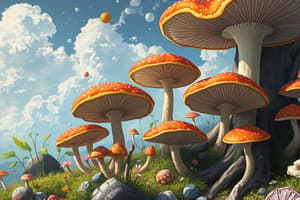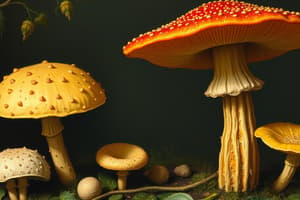Podcast
Questions and Answers
What are three reproductive strategies seen in protists?
What are three reproductive strategies seen in protists?
Binary fission, budding, and conjugation
What is the simpler process of reproduction used by some protists?
What is the simpler process of reproduction used by some protists?
Agamogenesis
Give an example of a unicellular alga that reproduces by binary fission.
Give an example of a unicellular alga that reproduces by binary fission.
Chlamydomonas
Which group of protists is capable of sexual reproduction to create gametes?
Which group of protists is capable of sexual reproduction to create gametes?
How do fungi primarily reproduce?
How do fungi primarily reproduce?
What role do plant-associated protists play in plant health and performance?
What role do plant-associated protists play in plant health and performance?
How do the morphology of gametes and spores vary between protists and fungi?
How do the morphology of gametes and spores vary between protists and fungi?
What are the two means by which both protists and fungi can produce daughter cells (or spores)?
What are the two means by which both protists and fungi can produce daughter cells (or spores)?
Explain the importance of unraveling the intricacies of protist and fungal reproduction processes.
Explain the importance of unraveling the intricacies of protist and fungal reproduction processes.
How do protists contribute to the overall complexity of eukaryotic organisms?
How do protists contribute to the overall complexity of eukaryotic organisms?
Study Notes
Protist and Fungi: An Overview of Reproduction
Protists and fungi are fascinating members of the microbial world, each with unique reproductive strategies. As we delve into the intricacies of their reproduction, we'll discover the differences and commonalities that set these eukaryotes apart.
Protist Reproduction
Protists display a wide variety of reproductive strategies, including binary fission, budding, and conjugation. Some protists can sexually reproduce by forming gametes, while others use a simpler process called agamogenesis. The specific method can vary greatly depending on the taxonomic group. For instance, the unicellular alga Chlamydomonas divides by binary fission, while plant-associated protists such as Colpoda cucullus are capable of sexual reproduction to create gametes.
Fungi Reproduction
Fungi primarily reproduce through the formation of spores, either sexually or asexually. Sexual reproduction involves fusing specialized gametes, resulting in the formation of a dikaryotic mycelium. This process commonly occurs in basidiomycetes and ascomycetes, with basidiomycetes producing basidiospores and ascomycetes producing ascospores. In contrast, asexual reproduction occurs through the production of spores by a single, haploid mycelium, such as in the case of yeast or mold.
Comparison of Reproduction Mechanisms
Protists and fungi differ in the complexity and type of reproduction, yet they share some fundamental features. Both groups produce daughter cells (or spores) by either sexual or asexual means, and both can experience a sexual process with the fusion of gametes. However, the morphology of their gametes and spores, as well as the overall complexity of their reproduction, varies greatly between the two kingdoms.
Protist Reproduction in Plants and Soil
Plant-associated protists play a crucial role in plant health and performance, with some species displaying beneficial traits such as disease suppression and nutrient uptake. Their reproduction can occur in plant tissues and the surrounding soil, where they contribute to the overall microbial community dynamics.
Conclusion
Protist and fungal reproduction are fascinating and diverse processes, contributing to the overall complexity of these eukaryotic organisms. Understanding the variation in reproductive strategies can help us appreciate the unique roles these microbes play in ecosystems, from the deep sea to the soil of a rice paddy. As we continue to unravel the intricacies of these processes, we'll gain valuable insights into the interactions between protists, fungi, and their environment, with the potential to improve our ability to manage soil health and plant health and performance.
Studying That Suits You
Use AI to generate personalized quizzes and flashcards to suit your learning preferences.
Description
Explore the fascinating world of protist and fungi reproduction in this quiz. Learn about the diverse reproductive strategies, including binary fission, budding, spore formation, and gamete fusion, that set these eukaryotes apart. Discover the differences and commonalities in their reproduction mechanisms and their roles in plant health and soil dynamics.




